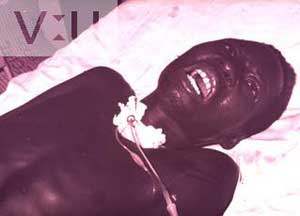To date, rabies remains an incurable disease once symptoms appear. Every year, approximately 30,000 to 50,000 people worldwide die from rabies. In Vietnam, over the past years, due to a widespread rabies vaccination program and increased public awareness, the rate of rabies-related deaths has gradually decreased. The number of deaths from rabies in the years 2000, 2001, and 2003 were 47, 60, and 30, respectively. However, the death toll from rabies rose to 82 in 2004. Therefore, the public must maintain a high level of awareness and vigilance against rabies to continue reducing the mortality rate from this disease.
* Causes of Rabies
Rabies is caused by a virus known as rabdovirus. The virus transmits to humans when a person is bitten by an animal infected with rabies. The rate of infection in humans depends on the infection rate in animals. In Vietnam, the animals most commonly transmitting rabies to humans are stray dogs; it can also be transmitted by cats, bats, monkeys, etc.
The rabies virus has a strong affinity for nerve cells. The virus at the bite site only replicates in small amounts in the tissue near the nerve cells, and if it is not killed by the body’s immune system, it will begin to invade the nervous system. After the virus invades the nervous system, the immune response created by the vaccine will no longer effectively destroy the virus. Bites on the head, face, and neck pose a high risk of causing rabies due to the virus’s ability to invade the central nervous system more quickly.
* Symptoms of Rabies
The incubation period for rabies ranges from 10 days to 1 year; the average incubation period is between 30 to 40 days. During this time, the virus gradually travels along the nerve pathways to the brain; symptoms of rabies will then begin to appear. The clinical manifestations of rabies infection in humans are quite complex but can be divided into two main forms:
– Encephalitic rabies: accounts for 70-80% of rabies cases. Patients exhibit altered consciousness, fear of drafts, fear of water; eventually, the patient will become confused and die.
– Paralytic rabies: paralysis usually starts at the bitten limb and gradually spreads to all limbs, the throat, facial muscles, and respiratory muscles.
In both forms, death is inevitable within 2-12 days after the onset of symptoms.
| Currently, with preventive healthcare facilities deployed nationwide, our country is gradually controlling rabies. In 2004, 610,810 people were vaccinated against rabies. However, around 82 people still developed rabies and died. The fatalities were reported across all regions: North (40 cases), Central (14 cases), South (22 cases), and Central Highlands (6 cases). Therefore, when bitten by an animal, people should not be complacent and must be aware of vaccination.
One of the top priorities is the immediate treatment of wounds from animal bites, scratches, or even when licked on the injured skin to minimize the amount of rabies virus at the entry site. The following actions should be performed promptly: wash the wound thoroughly several times under running water using soap or detergent; apply a disinfectant such as 70% alcohol solution or iodine solution at the wound site. Note that the wound should not be bandaged tightly. Go directly to the nearest preventive healthcare center for vaccination and further guidance. The biting animal should be monitored for 10 days; if the animal dies during this time, it should be reported immediately to health authorities. It can be said that rabies vaccine is a significant advancement in medicine, helping to combat rabies and saving countless lives. The rabies vaccine is essentially rabies viruses cultured in laboratories and then killed (or inactivated). Rabies vaccines are divided into two main groups: Fuenzalida vaccine and cell-cultured vaccine. The main difference between these two types of rabies vaccines lies in the environment used to culture the virus.Fuenzalida rabies vaccine is produced by culturing the virus in mouse brains. Therefore, during the purification process to separate the viruses, it is very challenging to eliminate all unnecessary components like proteins and myelin from mouse brains. These residual components, especially the remaining myelin (a component of nerve fibers), can cause neurological damage to the vaccinated individual, such as encephalitis, meningitis, transverse myelitis, etc. These damages may occur at a rate of approximately 1 in 8,000 to 1 in 27,000 cases vaccinated with Fuenzalida vaccine.
The cell-cultured rabies vaccine is produced by culturing the virus on cells. For example, the Verorab vaccine from France is produced by cultivating the rabies virus on Vero cells. Therefore, there are no remaining amounts of myelin, and thus it does not cause neurological disorders after vaccination. In recent years, the World Health Organization has recommended that countries gradually transition to using cell-cultured rabies vaccines, moving towards discontinuing the use of Fuenzalida vaccine. However, due to economic conditions, our country still uses both types of vaccines mentioned above for the public to choose from. Alongside vaccination with either of the two vaccines, depending on the location of the bite near the central nervous system, such as the head, face, neck, shoulders, chest, back, and areas with numerous nerves like fingertips, toes, genital areas, or deep wounds with multiple bites… patients may also receive rabies antiserum at the wound site. The purpose of injecting rabies antiserum at the wound is to neutralize the remaining virus at the site after washing the wound while waiting for the vaccine to produce antibodies for the patient. To date, rabies remains an incurable disease once symptoms develop, and it continues to cause many fatalities in Vietnam. Therefore, the public needs to be extremely cautious to avoid animal bites; when bitten, they should promptly visit preventive healthcare facilities for vaccination and timely consultation. |
Dr. Nguyễn Trung Nghĩa (Director of the Can Tho City Preventive Health Center)



















































